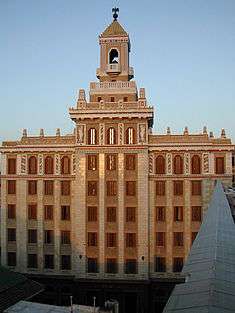Bacardi Building (Havana)

The Bacardi Building (Edificio Bacardi) is an Art Deco landmark designed by the architect Esteban Rodríguez-Castells and completed in 1930 in Havana, Cuba. It is located on the corner of Montserrat Street and San Juan de Dios on a 1,320 sq meter lot in Las Murallas, Old Havana.[1]
History
The Bacardi Building was designed to be the headquarters for the Bacardi rum company. The project was the outcome of a contest where Bacardi invited a limited number of architects to present their designs, offering 1,000 pesos to the winner. The contest was made up of a panel of judges that included Henri Schueg Chassin, president of the Bacardí company, and the architects Leonardo Morales, Enrique Gil, Emilio de Soto and Pedro Martínez Inclán, and the first prize was awarded to architect Esteban Rodríguez-Castells and his architect and engineer partners, Rafael Fernández Ruenes and José Menéndez Menéndez.[2]
Construction of the building started on January 6, 1930 and was completed by the 300-day deadline in December. Poor conditions of the land required that the foundation use piles of hard wood (jiqui and black júcaro) and concrete of high quality and resistance. At the peak of the building is a bronze sculpture of a bat, the symbol of the Bacardí company, on top of a small pyramid housing. Its design gives the building a unique chromatic effect and a decorative element of Catalan modernism. At the brim of the building are sculptures of sirens.
The first floor contained a bar with column archways where patrons of the restaurant in the mezzanine area could overlook the bar while they dined. It was open to the public and known to have many celebrities who frequented. Most of the marble and granite was brought in from European nations, such as Germany, Sweden, Norway, Italy, France, Belgium and Hungary.
With an area of 1,075 sq. meters and 7.25 meters of support, the first floor walls, floor and ceiling are adorned in pink granite from Bavaria, and the two halls are of green marble from floor to ceiling. The work was carried out by the company Grasyma of Wansiedel, Bavaria of Germany, which took great care in the fine details of the work and the time sensitivity of the project deadline.
The property had a cistern with capacity for 8,700 gallons of water, which pumped into a tank inside the tower with capacity for 4,800 gallons. In addition, it consists of four elevators for different uses: two are used for passengers with capacity of 10 people each and a speed of 350 feet per minute; another is a cargo elevator for the transportation of furniture, with a capacity of 4,000 pounds; and the fourth one makes trips between the basement and the first floor to transport goods.
Construction was completed in December 1930 and, at the time, was the tallest building in the city.[1]
After the Cuban revolution and the departure of Bacardí from Cuba, the building was used for national and foreign offices.[1] In 1963, Bacardí opened their U.S. head office in a building in Miami. In 2001, the building was restored thanks to the cooperation of an Italian firm. Inside it retains all the original decorations, marble and granite.[2] The building is regarded as one of the finest Art Deco buildings in Latin America.[3]
References
| Wikimedia Commons has media related to Bacardi Building (Havana). |
- 1 2 3 Emisora Habana Radio. "Edificio Bacardí" (in Spanish). Archived from the original on 2013-02-10. Retrieved 2009-11-05.
- 1 2 "Edificio Bacardí (Ciudad de la Habana) - EcuRed". www.ecured.cu (in Spanish). Retrieved 2018-09-01.
- ↑ "Edificio Bacardí". www.encaribe.org. Retrieved 2018-09-01.
Gallery
- Bacardi Building Photographs

.jpg)
.jpg)
.jpg)
.jpg)
23°08′20″N 82°21′26″W / 23.1389°N 82.3571°WCoordinates: 23°08′20″N 82°21′26″W / 23.1389°N 82.3571°W